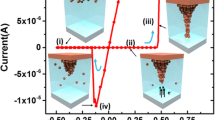Abstract
A memory element based on a Si/CaF2 periodic nanostructure is proposed. In this element, information is recorded through charge capture by trap states in a CaF2 dielectric. The high and low signal levels correspond to the current in the maximum and minimum of the negative differential resistance region, which forms as a result of the resonant tunnel distribution of charge carriers over trap levels in the dielectric. The speed of such logical elements depends on the rate of activation carrier trapping and the rate of tunnel carrier transfer from one state to another. It is shown that both Si/CaF2-based logical elements and memory elements proposed operate at temperatures from 77 to 300 K, have a switching time of 10−12–10−10 s, and are compatible with silicon IC technology.
Similar content being viewed by others
References
L. Esaki, Phys. Rev. 109, 63 (1958).
R. Tsu and L. Esaki, Appl. Phys. Lett. 22, 562 (1973).
C. G. Smith, Rep. Prog. Phys. 59, 235 (1994).
V. Ioannou-Sougleridis, A. G. Nassiopoulou, F. Arnaud d’Avitaya, et al., European Projects: Silicon Modules for Integrated Light Engineering (Marseille, 2000).
V. Ioannou-Sougleridis, T. Ouisse, A. G. Nassiopoulou, et al., J. Appl. Phys. 89, 610 (2001).
Yu. A. Berashevich, A. L. Danilyuk, A. N. Kholod, and V. E. Borisenko, Fiz. Tekh. Poluprovodn. (St. Petersburg) 35, 110 (2001) [Semiconductors 35, 112 (2001)].
Yu. A. Berashevich, A. L. Danilyuk, A. N. Kholod, and V. E. Borisenko, Fiz. Tekh. Poluprovodn. (St. Petersburg) 36, 91 (2002) [Semiconductors 36, 85 (2002)].
Yu. A. Berashevich, A. L. Danilyuk, and V. E. Borisenko, Fiz. Tekh. Poluprovodn. (St. Petersburg) 36, 718 (2002) [Semiconductors 36, 679 (2002)].
D. J. Paul, P. See, I. V. Zozoulenko, et al., Appl. Phys. Lett. 77, 1653 (2000).
M. Watanabe, T. Funayama, T. Teraji, and N. Salamaki, Jpn. J. Appl. Phys., Part 2 39, L716 (2000).
M. Watanabe, Yu. Aoki, W. Saito, and M. Tsuganazawa, Jpn. J. Appl. Phys., Part 2 38, L116 (1999).
K. J. Chen, T. Waho, K. Maezawa, and M. Yamamoto, IEEE Electron Device Lett. 17, 309 (1996).
V. Ya. Kirpichenko, Zh. Éksp. Teor. Fiz. 116, 1048 (1999) [JETP 89, 559 (1999)].
M. T. Cuberes, A. Bauer, H. J. Wen, et al., J. Vac. Sci. Technol. B 12, 2646 (1994).
Author information
Authors and Affiliations
Additional information
__________
Translated from Zhurnal Tekhnichesko\(\overset{\lower0.5em\hbox{$\smash{\scriptscriptstyle\smile}$}}{l} \) Fiziki, Vol. 73, No. 1, 2003, pp. 67–72.
Original Russian Text Copyright © 2003 by Berashevich, Korolev, Danilyuk, Borisenko.
Rights and permissions
About this article
Cite this article
Berashevich, Y.A., Korolev, A.V., Danilyuk, A.L. et al. Memory element based on Si/CaF2 periodic nanostructures. Tech. Phys. 48, 63–67 (2003). https://doi.org/10.1134/1.1538729
Received:
Issue Date:
DOI: https://doi.org/10.1134/1.1538729




